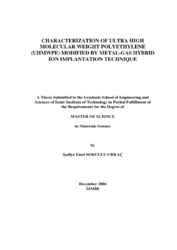Please use this identifier to cite or link to this item:
https://hdl.handle.net/11147/3730| Title: | Characterization of Ultra High Molecular Weight Polyethylene (uhmwpe) Modified by Metal-Gas Hybrid Ion Implantation Technique | Authors: | Urkaç Sokullu, Şadiye Emel | Advisors: | Tıhmınlıoğlu, Funda | Publisher: | Izmir Institute of Technology Izmir Institute of Technology |
Abstract: | The aim of this work was the characterization of the surface modified Ultra High Molecular Weight Polyethylene (UHMWPE) in order to understand the effect of ion implantation technique on the properties of this material. The samples were Ag and Ag+N hybrid ion implanted by using MEVVA (Metal Vapour Vacuum Arc) ion implantation technique with a fluence of 10 17 ions/cm2, extraction voltage of 30 kV.Untreated and surface treated samples were investigated by Stopping andRange of Ions into Matters (SRIM), Rutherford Back Scattered Analysis (RBS), Attenuated Total Reflection - Fourier Transform Infrared (ATR/FT-IR) Spectroscopy, Raman Spectroscopy, Optical Absorption Photospectroscopy (OAP), Thermo Gravimetry Analysis (TGA), Differential Scanning Calorimetry (DSC), X-Ray Diffraction (XRD) Analysis, Atomic Force Microscopy (AFM), Scanning Electron Microscopy (SEM), Optical Microscopy (OM), Micro-hardness and Contact Angle Measurement. The results of RBS analysis show that Ag ions were detected up to 32 +15 nm after Ag implantation, and 42 +15 nm after Ag+N implantation., underneath the surface. ATR- FTIR chemical characterization analyses results indicated that the effect of implantation on UHMWPE surfaces caused dehydrogenation of polymer with an increase of C.C bond formation which results in enriching the crosslinking carbon atoms on the surface. Optical Absorption Photospectroscopy and Raman spectrum suggests that the chemical structure of UHMWPE has changed after implantation. The characterization results showed that the ion bombardment induced an increase in the % crystallinity, onset and termination degradation temperatures of UHMWPE obtained by thermal analyses, an increase in hardness, and surface wettability and a decrease in roughness of the polymer. The surface topography results can be attributed to the implantation inducing surface roughness decreasing due to the better wettability properties of surfaces obtained after implantation. In conclusion, this study has shown that ion implantation represents a powerful tool on modifying key properties on UHMWPE surfaces. | Description: | Thesis (Master)--Izmir Institute of Technology, Materials Science and Engineering, Izmir, 2006 Includes bibliographical references (leaves: 70-76) Text in English; Abstract: Turkish and English xii, 77 leaves |
URI: | http://hdl.handle.net/11147/3730 |
| Appears in Collections: | Master Degree / Yüksek Lisans Tezleri |
Files in This Item:
| File | Description | Size | Format | |
|---|---|---|---|---|
| T000576.pdf | MasterThesis | 3.12 MB | Adobe PDF |  View/Open |
CORE Recommender
Page view(s)
232
checked on Apr 21, 2025
Download(s)
142
checked on Apr 21, 2025
Google ScholarTM
Check
Items in GCRIS Repository are protected by copyright, with all rights reserved, unless otherwise indicated.